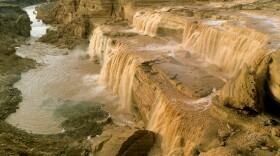Don't try the Kelly Grade in a rainstorm. When this steep stretch of the Smoky Mountain Road is wet, its mud surface is impossibly slick. Stay in granny gear, keep a tight grip on the wheel, and hope that nobody else is coming the other way. There's no guardrail and that cliff next to your tires drops hundreds of feet straight down. The shale gives way to sandstone when the road straightens out on top of the Kaiparowits Plateau.
Dangle your legs over the edge and soak in the view – the glistening waters of Lake Powell to the south, the blue shoulder of Navajo Mountain to the east. You've just climbed a thousand feet up most of the Grand Staircase, with its brown, white, vermilion, grey, and pink cliffs that showcase geology's Mesozoic era. The cliffs at your feet have been carved into a fretwork of canyons here on the plateau’s southern flank. Dark bands of coal are interlaced among the sandstone and shale layers.
Rounding a bend, the odor of creosote stings your nostrils. Ghosts of gray smoke swirl like genies as they escape from a hole in the ground. That’s coal you smell, burning deep underground. Lightning could have started the fires, or maybe spontaneous combustion. The fires have been smoldering for hundreds, perhaps thousands, of years. As seams of coal burn to ash, the ground collapses and wicked cracks propagate toward the surface. The surrounding soil is baked to brick-red stones called “clinkers.” Around the vents is a black smudge that unmistakably announces the presence of carbon.
The coal was deposited ninety million years ago during the Cretaceous. In those days Utah was beachfront property, sitting alongside an interior seaway. It was subtropical – rainy and warm like a mangrove swamp today. Plants growing in soggy bogs along the coast died and decayed in incredible quantities, collecting as peat. Over time thousands of feet of sediment piled on top, and the peat was pressed into coal. This was an auspicious moment in earth's history – flowering plants had only recently arrived on the scene, elbowing aside conifers and ferns. All were part of the muck that would become coal on Kaiparowits Plateau.
Early Mormon settlers from the village of Escalante, Utah, used pick and shovel to mine the BTU-laden black rock. It was slow hard work, and they took just enough to heat their homes and backhouses. Starting in the 1960s, more than a thousand test holes were drilled as large energy companies explored the reserves. There’s still a lot of coal on the Kaiparowits – 62 billion tons by the US Geological Survey’s estimate. Plans were drawn up for huge underground mining operations and a 5000 megawatt power plant. But those industrial ambitions were shelved when the plateau was incorporated into the Grand Staircase-Escalante National Monument in 1996.
Though still deep underground, the coal and its fossils open a window into the past when flowers first took over the world. Still burning, the vents of Smoky Mountain serve as a reminder, if these resources were exploited, how much carbon would be released into an already warming atmosphere.






